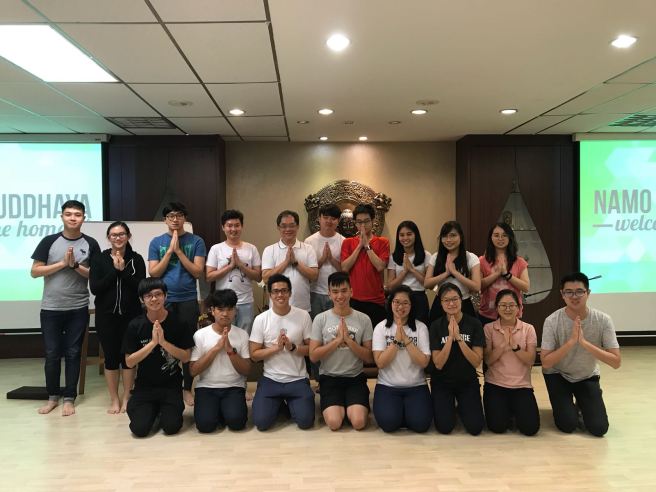09/06/18
Talk by Bro Tan Siang Chye

Nothing quite jolts one into contemplation of the inherent suffering of life than the sudden loss of someone whom we love, respect or idealize. Bro Tan Siang Chye opened his talk on “Life’s Greatest Refuge” on this note as he shared with all the suicide of Anthony Bourdain, one of Bro Tan’s favorite celebrity chef, just a day before on 8th June, Friday. American fashion designer Kate Spade, founder of the famous fashion brand of the same name, also took her life earlier in the week on 5th June, Tuesday. Another household celebrity name who ended his own life about a year ago was Chester Bennington from Linkin Park. These are people that seem to possess many things desired for by many, yet evidently, they were still besieged by much suffering. Contemplating wisely, we should indeed ask ourselves what we really seek for refuge in our lives, especially in an increasingly uncertain and hostile world.

The motivation for us to seek refuge comes from the understanding that suffering is inherent in life. However, Bro Tan shared that he had actually received many comments by youths stating that they were actually not suffering and hence, were not compelled to seek a refuge. This is actually a very complacent and inaccurate view. In fact, there is a global rising trend of people being clinically depressed. Besides, it is important for us to realize that even though things are alright now, with time, we are bound to experience a certain amount of suffering. As Ajahn Cattamalo shares, “Happiness is merely a period between two periods of sadness; sadness too is merely a period between two periods of happiness”. Our life is really just a sinusoidal flow of happiness and sadness, hence even during the peaks, there is really no room for complacency.
In view of suffering, most of us are habitually conditioned to seek refuges like family, friends, wealth, fame, job etc. To distract ourselves from the discomfort, we like to engage in activities like retail therapy, indulgence in food, listening to music, or just to do things… anything really! This is because busyness in itself is often used as a distraction technique too. However, we got to be honest with ourselves. Are these really true refuges?

If we are practicing Buddhists, our true refuge should be the Triple Gems. This means to look upon the Buddha as proof that enlightenment exists – and to bring this understanding inwards to realize that we have the human potential to transcend suffering ourselves; to learn and practice the Dhamma so that we can experience the corresponding fruits of release; and finally to venerate the well-practiced Sangha and to see them as role models for our spiritual practice.
This is not always a simple endeavor. We are used to following our likes and dislikes, and many of our Buddhist practices actually run against our natural tendencies. However, if we do not put in the effort to resist our craving and to invest effort in practicing the Dhamma, it is us that will lose out in the end. Thanissaro Bhikkhu elucidates this point refreshing well in his talk “Beyond Likes & Dislikes” 1, and an excerpt is as follows:
“As the Dhamma comes to the West this is probably one of the hardest things for Westerners to appreciate. Everywhere you look, the Dhamma is being remade, recast, so that people will like it. Things that people don’t like are quietly cut away; and if things that people like are missing, they’re added on. And so the creature that comes out is like the old cartoon of a committee designing a bird: The bird looks pretty good to begin with, but then after the committee’s done with it, it looks like an ostrich with no legs. It can’t walk and it can’t fly, but it sells. In this country of ours, where democracy and the marketplace are all-powerful, the question of what sells determines what’s Dhamma, even if it can’t walk or fly. And who loses out? We lose out. The Dhamma doesn’t lose out; it’s always what it is. But we like to add a little here, take away a little there, and as a result we end up with nothing but things we already like and already dislike.”

Bro Tan further encouraged us in our practice by raising two interesting case studies. The first was that of Malaysian Billionaire Ananda Krishnan 2 (3rd wealthiest man in Malaysia), whose only son ordained as a monk (Ajahn Siripanyo) more than two decades ago. Learning about how Ajahn Siripanyo gave up his tremendous wealth to become a monk who owns close to nothing is indeed something very inspiring. Currently, Ajahn Siripanyo serves as the abbot of Dhao Dham Monastery, located in National Forest Reserve near Thai-Myanmar border. The other interesting case study that Bro Tan raised was that of Matthieu Ricard 3, who was called the “World’s Happiest Man” after participating in a 12-year brain study on meditation and compassion led by a neuroscientist from the University of Wisconsin, Richard Davidson.
In the hustle and bustle of life, it is indeed very easy for us to lose sight of what truly matters in life and what we should seek for refuge in. But through these constant reminders and from our interactions with esteemed teachers and precious Kalyana Mittas, may we always have the mindfulness and wisdom to always come back to our heart, to the precious Dhamma!

2 https://hubpages.com/religion-philosophy/Modern-Age-Siddharta-Gautama